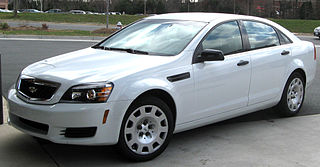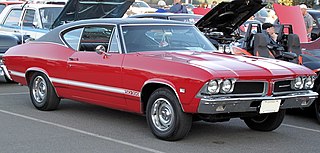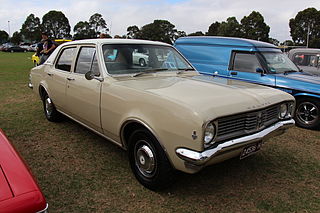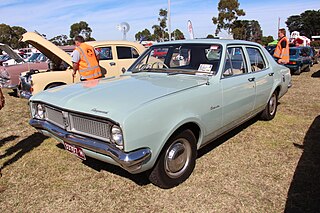
The Chevrolet Caprice is a full-size car produced by Chevrolet in North America for the 1965 through 1996 model years. Full-size Chevrolet sales peaked in 1965, with over a million units sold. It was the most popular car in the U.S. in the 1960s and early 1970s, which, during its production, included the Biscayne, Bel Air, and Impala.

The Holden Monaro is a car that was manufactured by General Motors' Australian division Holden. It has a front-engine, rear-wheel-drive layout and was produced with a two-door coupé body from 1968 to 1975 and again from 2001 to 2006 and with a 4-door sedan body from 1973 to 1977.

The Chevrolet El Camino is a coupé utility vehicle that was produced by Chevrolet between 1959–1960 and 1964–1987. Unlike a standard pickup truck, the El Camino was adapted from the standard two-door Chevrolet station wagon platform and integrated the cab and cargo bed into the body.

The Chevrolet Chevy II/Nova is a small automobile manufactured by Chevrolet, and produced in five generations for the 1962 through 1979, and 1985 through 1988 model years. Built on the X-body platform, the Nova was the top selling model in the Chevy II lineup through 1968. The Chevy II nameplate was dropped after 1968, with Nova becoming the nameplate for all of the 1969 through 1979 models. It was replaced by the 1980 Chevrolet Citation introduced in the spring of 1979. The Nova nameplate returned in 1985, produced through 1988 as a S-car based, NUMMI manufactured, subcompact based on the front wheel drive, Japan home-based Toyota Sprinter.

The Holden Caprice is a full-size car which was produced by Holden in Australia from 1990 to October 2017. The similar Holden Statesman, which was also introduced in 1990 as a model below the Caprice, was discontinued in September 2010. Between 1971 and 1984, Holden marketed their long-wheelbase sedans under the Statesman marque.

The Holden Kingswood is a full-size car that was developed and manufactured in Australia by Holden, from the beginning of the HK series in 1968 through to the conclusion of the WB series in 1985. Prior to 1968, the full-size Holden range of family cars comprised the Holden Standard, the Holden Special, and Holden Premier models. Initially, the HK range of models included the basic Holden Belmont, the Kingswood, and the luxury-oriented Holden Premier, all of which were manufactured in a choice of sedan and station wagon bodies. Commercial variants were offered in three types: coupé utility, panel van, and later from 1971, a heavy-duty Holden One Tonner cab chassis. The utility (ute) version was originally marketed in both Belmont and Kingswood configurations. However, after the Belmont name was deleted from commercials at the end of HQ in late 1974, the base model commercials were sold only with the "Holden" badge.

The Pontiac Parisienne is a full-size rear-wheel drive vehicle that was sold by Pontiac on the GM B platform in Canada from 1958 to 1986 and in the United States from 1983 to 1986. Right-hand drive models were locally assembled in Australia, New Zealand, and South Africa until 1969. For most of its run, the Canadian Parisienne was nearly mechanically identical to the American Chevrolet Impala or Chevrolet Caprice. The Parisienne wagon continued under the Safari nameplate until 1989. Parisienne or La Parisienne means a grammatically female person or thing from Paris, France.

The Chevrolet Constantia is an automobile which was marketed by Chevrolet in South Africa from 1969 to 1978.
The Powerglide is a two-speed automatic transmission designed by General Motors. It was available primarily on Chevrolet from January 1950 through 1973, although some Pontiac models also used this automatic transmission after the fire at the Hydra-Matic factory in 1953. Powerglides were used extensively on Pontiacs produced for the Canadian market with Chevrolet powertrains. They were also used with Nova engines in the DJ-5A Jeeps produced 1968-1970 by Kaiser-Jeep and widely used as delivery vehicles by the United States Post Office. When introduced on upper-level Chevrolet models in 1950, the Powerglide represented the first automatic transmission offered in a low-priced automobile; in contrast, Ford did not offer their automatic transmission until 1951, while Plymouth car buyers had to wait until 1954. The transmission was simple and very durable, which satisfied customers.

The Ford Fairlane and LTD are full-sized luxury vehicles produced in a series of models by Ford Australia between 1959 and 2007.

Beaumont was a make of mid-sized automobiles produced by General Motors of Canada from 1964 to 1969. These cars were based on the Chevrolet Chevelle, but the line had its own logo and nameplate, and was neither marketed nor actively sold in the United States. Its logo consisted of an arrow, similar to that of Pontiac, but with a maple leaf to signify its dual heritage from both sides of Lake Ontario.

The Holden was a full-sized car produced by the company of the same name across 5 generations from 1948 until 1984. The Holden is also commonly referred to by their model designation and also the H Series. The Holden was introduced to be Australia's car, being the first full scale produced automobile exclusive to the country. Prior to which, General Motors Holden's Ltd. assembled imported CKD kits from overseas General Motors subsidiaries such as Chevrolet, Buick, Vauxhall and more. And the only other cars built in the country being Ford and Chrysler vehicle bodies fitted to imported chassis. The Holden was an instant success among Australians, being the first production car built solely for Australia's unique, rough roads.

The Chevrolet 210 or Two-Ten is a midrange car from Chevrolet that was marketed from 1953 until 1957. It took its name by shortening the production series number 2100 by one digit in order to capitalize on the 1950s trend toward numerical auto names. The numerical designation "210" was also sporadically used in company literature. It replaced the Styleline DeLuxe model available in previous years. The 210 was discontinued after the 1957 model year to be replaced by the Biscayne.

Statesman is an automotive marque created in 1971 by the Australian General Motors subsidiary, Holden. Statesman vehicles were sold through Holden dealerships, and were initially based on the mainstream Holden HQ station wagon platform, thereby providing more interior room and generally more luxurious features than their Holden-branded sedan siblings. Production ceased with the last of the WB series cars in January 1985.

The Holden HQ series is a range of automobiles that was produced by Holden in Australia from 1971 to 1974. The HQ was released on 15 July 1971, replacing the Holden HG series. It was the first ground-up redesign of the Holden line since its original release in 1948, and included an all-new body, chassis, and suspension. The HQ was later developed into a series of successor models, finally ending production when the WB series was discontinued in 1985.

The Holden V8 engine, also known colloquially as the Iron Lion engine, is an overhead valve (OHV) V8 engine that was produced by the Australian General Motors subsidiary, Holden (GMH), between 1969 and 2000.

The Holden HK series is an automobile which was produced by Holden in Australia from 1968 to 1969. Introduced in January 1968, the HK range progressively replaced the Holden HR series which had been in production since 1966. HK models were both larger and heavier than their predecessors and the range would ultimately include thirteen different models against the eight of the HR range. The Holden HK was marketed under Belmont, Kingswood, Premier, Brougham and Monaro model names.

The Holden HT series is a range of automobiles which was produced by Holden in Australia between 1969 and 1970.

The Holden HG is an automobile which was produced by Holden in Australia between 1970 and 1971. It was marketed under Belmont, Kingswood, Premier, Brougham and Monaro model names.

The Holden HR is an automobile that was produced by Holden in Australia from 1966 to 1968.























